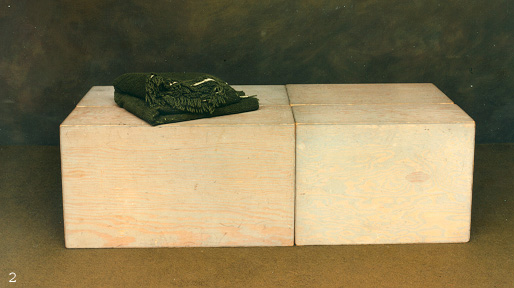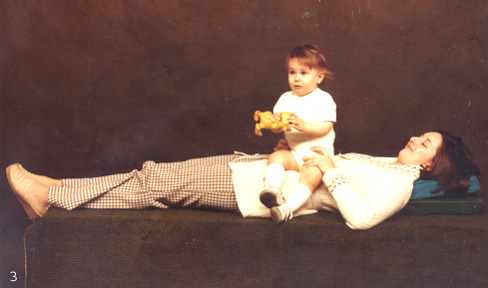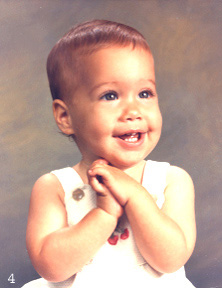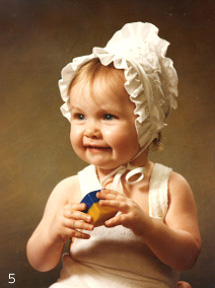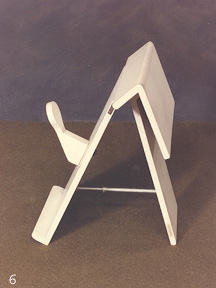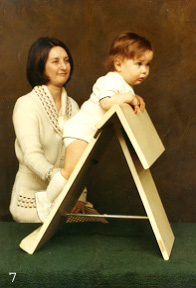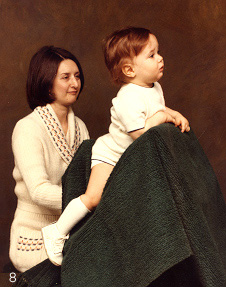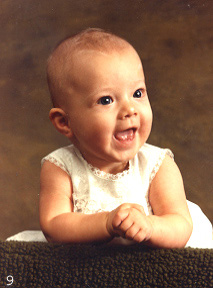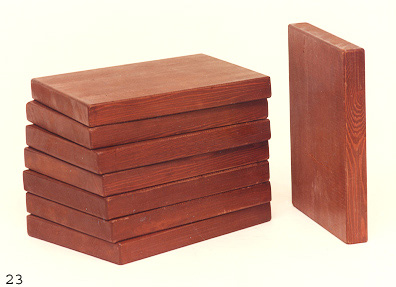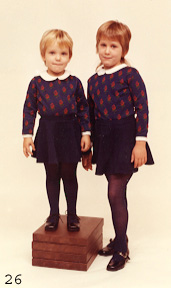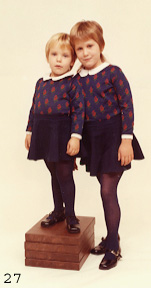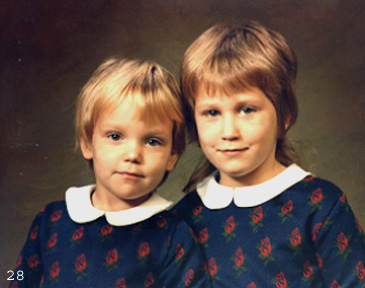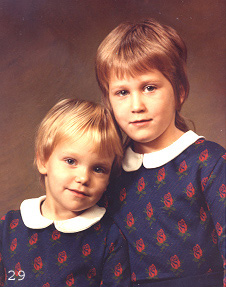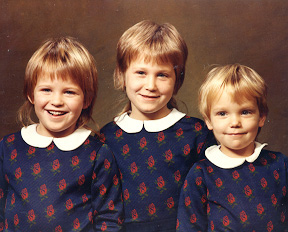|
The Zeltsman Approach to Traditional Classic Portraiture Chapter 10 Posing Babies and Young Children I always posed Babies and Young Children in the same classic formal style as adults, either in a masculine or a feminine composition. Thus, the posing instructions in my chapters on Posing Men and Posing Women also apply in this chapter for posing Children, as you will see. Indeed, the facial evaluation and pre-planning procedure at the start of an adult session also applies to children, but with a different approach. A reminder: As mentioned earlier, an adult session of an individual subject always begins with a short facial evaluation and planning session. (See Chapter 3) Its purpose is to allow you to decide which facial view or views you will want to photographs. That information is important at the start of the session, because you choice of facial angle determines how to pose the body to effectively support that view of the face. Obviously you also need this important information when doing a portrait of a child. But such facial evaluation and planning sessions are, of course, not possible with Babies and Young Children. Therefore, a different approach is needed. Difference in Approach Unlike adults, babies and young children can not be directed and told what to do, and therefore require a psychological (sneaky) approach. Ideally, controlled portraiture of children is a team endeavor. You need a helper who can engage and keep a child�s interest and attention, and keep the child entertained while you do the following: 1. Look at the child�s face, and decide which side view of the face you will photograph. 2. That will indicate how the body must be posed. 3. Head and Shoulders? Three quarter length, seated or standing? Full length, seated or standing? 4. Whatever pose you decide on first, the necessary props are brought in and set up. 5. And, because you know exactly what the pose will look like, you set up the lighting where you�ll need it, and the set is then ready for the child to be brought in. The above, although speaking directly to you, explains my approach to formal classic portraiture of children up to the point when the child is brought on the set. Study the variety of portraits of children that follow, see how they were made, and the props used in arranging those poses.
These four blocks used separately, offer a variety of height levels useful in many situations. The blocks are constructed of 3/8 inch plywood, each of different dimensions, as follows: 16x20x28. 12x20x28. 16x20x36. 12x20x36.
When the four blocks are combined as shown in the #2 photo, the resulting platform is 20 inches high with a 28x64 inch posing area. I use this platform covered by a rug that matches the background, to pose babies and young children in a variety of poses, as you will see.
A familiar sight you will agree, is a Mother who always carries her baby straddled on her hip. More likely than not, this indicates a very strong physical bond between them, and when Mother wants a portrait of baby, a stranger/photographer discovers there is no way to get the baby into the posing area. That is what this illustration is all about. The four blocks are combined to form this platform. Mother lies down, and the baby is happy to remain with Mother, as illustrated here. An easy way to get some lovely head and shoulders close-ups of the baby. I also like to include the baby�s hands, and in order to do that, the hands have to be raised to exclude Mother. Giving the baby something to hold, as shown here, always works. Indeed, occasionally, a baby will raise the hands in a spontaneous response to our entertainment, as you can see.
Both of the above portraits were made of the babies sitting on Mother lying down.
This baby poser was designed to serve one specific purpose; To provide a safe and convenient means for supporting a baby in an upright position to be photographed, when a baby is still too young to sit up unsupported. The A-shaped structure of the poser is hinged, and the adjustable metal cross bar allows it to be locked in any position. As shown in the photos, the poser may be locked in its maximum open position to be placed on my platform. Note that Mother can sit just our of camera range to keep the baby absolutely safe. The poser is covered with a small rug before the baby is place on it. Next three photos show the lovely portraits of the two babies, made possible by this prop.
I remember struggling, as many other photographers did, and still do, trying to find some effective way to pose a baby too young to sit up unsupported. And now, these three lovely portraits, showing the babies looking relaxed and happy and at their best, is my approach to posing the very young baby. But when they are older and are comfortable and relaxed sitting up, I pose them in full length, thus adding the appeal of the total baby, as shown in the next two photos.
Note the platform in use here for posing the babies in full length, and its use next when posing older children in full length, seated and standing. Before proceeding, I also want to introduce the stools you will see used in other arrangements.
I designed this group of assorted height stools for posing children of different ages, so each child could be provided with a proper height stool for its size, and be posed comfortably in a seated arrangement. You�ll see how these stools are used to pose children in full length seated poses, and also in head and shoulders arrangements. And the stools are extremely important when arranging groups. The heights of the stools are as follows: The shortest is 10 inches high. The next two are 12 inches. Each of the remaining three is 14, 15, and 16 inches. The seat measurements are as follows: The shortest is 8x10 inches. The next three 9x12. The two tallest are 11z14.
I like to pose the children on the platform for two reasons. One: I can control the horizon line. And two: The background light is conveniently concealed behind the platform. As you can see, the little boy is seated here on a stool of just the right height, to allow his body to assume this relaxed and very effective masculine composition. This is a planned portrait from start to finish. It was to be full length. The clothing was planned. Appointment time, while the boy was entertained and occupied, I did a sneaky evaluation, decided what direction to turn the body, set up the platform, placed the proper height stool on it, turned in the direction I decided his body will face, arranged the lights where I knew I�d want them to be, and NOW, continuing all the fun, he was brought on the set all ready for him, and would you believe it, HE SAT DOWN just like that, in a masculine pose. My reason for describing all those details? All my portraits of children are planned and handled that way.
Having decided how to arrange the little girl in this full length standing pose, she was positioned on the platform, her body turned just a bit to her left, with the feet side by side facing in the same direction. Now, look at the placement of her feet in this photo. They are in a classic position for arranging a full length standing pose of a man or a woman, as I demonstrated in both Posing the Man and Posing the Woman chapters. Adults, of course, are simply directed to place their feet that way. But when posing children, I actually have to arrange their feet, and here is how I do it. While I talk to the child about anything, I get down in front of her, and keeping her steady with one hand I place my other hand on the front foot, gently pulling it forward and turn it with the toes facing me. I then reach behind her knee and very gently push her knee into a slight bend which causes her weight to shift down on to her back leg. Why the doll? That is to cause her arms to bend into diagonals. What you are looking at is a perfect feminine composition. And how about a turn of the face to show a front view? Takes a long time to talk about all this, but only a few moments to DO IT. I�ve done it thousands of times, boys and girls. Always works, because it is a very comfortable and relaxed body position.
In this photo of two children, you see why I provided myself with an assortment of different height stools. The stool the girl is sitting on is exactly the right height for her size, allowing her to be seated comfortably to achieve this pose with her younger brother standing. Note the boy in this photo is in a pure masculine pose, his feet as I arranged them to cause him to assume this classic pose. The next photo shows the props combination I use in posing close up poses of children.
One of the four (platform) blocks, placed on the round turn platform, and stools in a choice of heights, provide a very effective and versatile platform for arranging children of all ages in close up head and shoulders poses. And the rotating feature of this platform provides an easy way to relate additional views of a completed pose to the camera, without disturbing the pose.
In close ups of babies and very young children like this little girl, I like to show more of the child, and that is generally accomplished by including hands in the composition. As you are looking at this pose, imagine a slight turn of the platform to bring the front view of her face to the camera. A new pose without changing anything, just a slight correction of the main light.
These two older children, as shown in the two photos above, are also on the rotating platform, sitting on stools of comfortable height for them. After taking the pose of the girl in the photo on the left, a slight turn of the platform can bring her front view of the face to the camera for a variation. Likewise of the boy. He is in a masculine composition, and after taking this front view of his face, the platform may be used to turn either one or the other side views of his face to the camera.
During my usual brief pre-sitting evaluation of this child, I could not overlook the quiet charm of what she was wearing, and decided to pose her as you see in this photo, including hands and the styling of her dress. The prop her hands are resting on is the back of a dark velvet upholstered chair, which I use very often in three-quarter length poses, not only of children as in this portrait, but also of men and women. However, when children of different heights are placed behind this prop (back of the chair) to be posed in this manner, they each require the prop to be of proper height for the hands to rest there comfortably. Simple solution: The child is placed on one or more wood blocks to achieve the necessary height relationship for posing the hands.
|
|
These blocks of wood are used in a number of ways. Adding one or two blocks to a stool to gain seat height when necessary. Placing a block on a chair when you want someone to appear taller. Standing a child on one or more blocks to alter the child�s height in relation to a prop. Or adjusting the height between children who are standing, for a closer relationship between their faces for a close up. The blocks are obtained by cutting a 2x12 inch board in to 14 inch long pieces. A good quality light weight wood, such as redwood, is best for that purpose. The blocks should be finished off and stained in a dark color to match the posing stools. The next four photos show a step by step progression, of how the two children shown in the first photo (#24) are brought together for a close-up head and shoulders pose (photo #27).
First, the oldest child stands with a slight turn of the body to her right. Then standing the younger sister on blocks to bring her face up to whatever height relationship you want to achieve, as shown in photo #26. And when she is standing on the blocks at your chosen height, a slight turn of her body, also to her right so their bodies are parallel, you bring them together, as illustrate in photo #27.
The portrait on the left is the pose as it was arranged in the group of four photos above. But I wanted the portrait to project a more realistic age relationship between these two sisters. All I did to achieve that in the portrait on the right was to remove one wood block under the younger sister. Actually, there are three sisters. Note how the close up portrait of the three lovely faces projects an instant awareness of the actual age relationship between them, arranged with the aid of the wood blocks, photo #31 below.
And below is the actual portrait I made of these three charmers for the family.
The pose is arranged on the platform (4 of the blocks combined) rather than on the floor. That allows a convenient working height of the camera and control of the horizon. The indication of the age relationship between them is achieved by using stools of different heights. CLOSING COMMENTS and RELEVANT SUGGESTIONS A reminder: I stated that my posing approach in portraying children is the same as for adults. Every pose is arranged in either the masculine or the feminine composition. If you need to, you can review my detailed step by step posing instructions in the four chapters dealing with Posing Men and Posing Women. This chapter on Posing Babies and Young Children, is mainly a "show and tell" on how the various poses throughout this chapter are arranged with the aid of PROPS. Relevant suggestions: After studying how these portraits are arranged, I suggest that aside from my comments, you return to each of the portraits to study the following: Choice and coordination of clothing. Background. The use of hands. Tonal coordination of everything within the picture area. And portrait lighting. |
Rehosted on:


